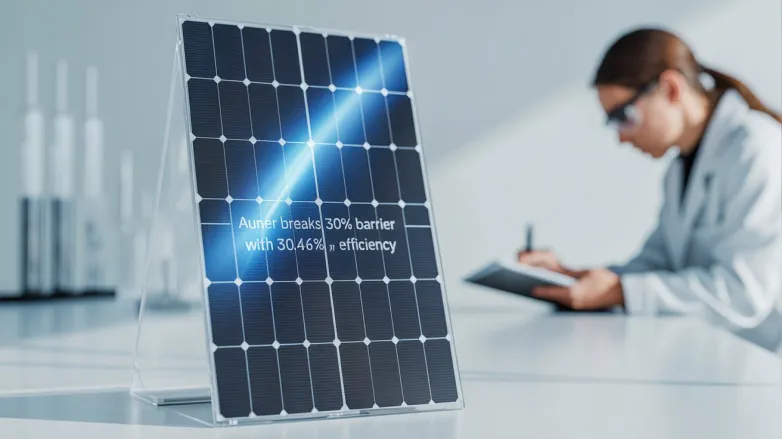Auner Breaks 30% Barrier with 30.46% Perovskite-Silicon Module Efficiency Record
- Chinese innovator Auner hits a certified 30.46 % efficiency in a G12 perovskite/silicon tandem module, eclipsing its May mark and gearing up for pilot production.

Chinese start-up Auner has crossed the symbolic 30-percent threshold for tandem solar modules, announcing a certified power-conversion efficiency (PCE) of 30.46 % for its perovskite/crystalline-silicon device based on the G12 half-cell format. The figure, verified by the Fujian Institute of Metrology, exceeds the company’s own 29.69 % record set barely two months ago.
The module pairs a wide-bandgap perovskite absorber with a passivated rear-contact silicon bottom cell, allowing each sub-cell to harvest a different slice of the solar spectrum and push well beyond the single-junction Shockley-Queisser limit. At 30.46 %, Auner’s result is among the highest reported for a commercial-sized tandem module and only fractionally shy of Trina Solar’s 30.6 % mark certified in June.
Auner credits a suite of process tweaks for the jump in performance:
-
Perovskite composition tuning to optimise bandgap alignment with the underlying silicon.
-
Vacuum-assisted blade coating on full-area G12 wafers to deliver pinhole-free perovskite layers.
-
Low-temperature interconnection to minimise thermal stress and preserve layer integrity.
Beyond the laboratory, the company says it now “possesses the complete technical toolkit” to enter pilot-scale manufacturing. Auner’s engineers are finalising a 100-MW pilot line in Fujian province where they will run manufacturability and durability trials over the next six months. Findings will feed into the design of a planned gigawatt-scale plant scheduled for 2026.
Hitting the 30 % milestone matters commercially as well as scientifically. Industry analysts note that every percentage-point gain in module efficiency trims balance-of-system costs and land use, key metrics for utility-scale solar developers. While today’s mainstream p-type PERC panels plateau around 22.5 % in mass production, perovskite-silicon tandems promise to leapfrog that ceiling—even after factoring in inevitable efficiency losses during scaling.
Yet challenges remain. Tandem modules must prove 25-year durability, secure bankability endorsements and navigate perovskite supply chains still in their infancy. Auner says accelerated-aging tests on 60 × 120-cm prototypes have already surpassed 1,000-hour damp-heat and thermal-cycling thresholds, with extended IEC-certification campaigns under way.
If the company can translate laboratory success into factory output, it will join a short list of players racing to commercialise perovskite-silicon tandems—technology many observers view as the next big step toward the elusive 40 % module on the ground and the terawatt-scale solar future.
Also read


